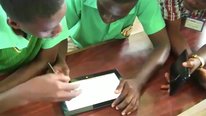
KEVIN ASHLEY
ArgumentPeer Project
NSF Awards: 1122504
In the ArgumentPeer project, the computer shares responsibility with peers and teacher for helping learners across disciplines (law, science) construct well-warranted arguments. The software provides infrastructure for structuring an argument and can automatically provide feedback about the argument’s structure and what might be missing, and peers critique the content of arguments-in-progress.
ArgumentPeer Project
NSF Awards: 1122504
In the ArgumentPeer project, the computer shares responsibility with peers and teacher for helping learners across disciplines (law, science) construct well-warranted arguments. The software provides infrastructure for structuring an argument and can automatically provide feedback about the argument’s structure and what might be missing, and peers critique the content of arguments-in-progress.
-
 Mobile Response System: Interactive Problem Solving
Mobile Response System: Interactive Problem Solving
Mohammad Muztaba Fuad
-
 Fostering Ecologies of Online Learners
Fostering Ecologies of Online Learners
Marcela Borge
-
 SimScientists Human Body Systems
SimScientists Human Body Systems
Daniel Brenner
-
 Using Data Visualizations to Empower Informal STEM Educators
Using Data Visualizations to Empower Informal STEM Educators
Caitlin K. Martin
-
 Teacher Creativity: Content, Student Cognition, Dig. Media
Teacher Creativity: Content, Student Cognition, Dig. Media
Eric Hamilton
-
 The Power of Project-Based Inquiry Science CyberPD
The Power of Project-Based Inquiry Science CyberPD
Barbara Zahm
5118 Views
Continue the discussion of this presentation on the Multiplex. Go to Multiplex
5118 Views
Related videos you might be interested in...
-
 Mobile Response System: Interactive Problem Solving
Mobile Response System: Interactive Problem Solving
Mohammad Muztaba Fuad
-
 Fostering Ecologies of Online Learners
Fostering Ecologies of Online Learners
Marcela Borge
-
 SimScientists Human Body Systems
SimScientists Human Body Systems
Daniel Brenner
-
 Using Data Visualizations to Empower Informal STEM Educators
Using Data Visualizations to Empower Informal STEM Educators
Caitlin K. Martin
-
 Teacher Creativity: Content, Student Cognition, Dig. Media
Teacher Creativity: Content, Student Cognition, Dig. Media
Eric Hamilton
-
 The Power of Project-Based Inquiry Science CyberPD
The Power of Project-Based Inquiry Science CyberPD
Barbara Zahm
Victor van den Bergh
Project Manager
Dear Kevin and your team at LRDC,
Thank you for sharing this interesting research. It seems that you have hit upon a very important topic and I appreciate your approach to resolving what is certainly a prevalent issue in academia. I was wondering if you could shed some light on how you imagine writing and argumentation teachers might be able to use the key novel action of your software (namely, the automatic generation of argument outlines) to deepen law and medical students’ understanding of how to construct an argument. For example, will you be developing (or have you developed) a curriculum around this to help users understand the strengths of the generated outline? I would imagine that this would lead well into the peer-review stage you propose exploring next.
Kevin Ashley
Thanks for your query, Victor!
We have developed a two-week exercise to teach law students to make arguments concerning a legal issue called the “Duty to Aid”. Students read a hypothetical scenario involving “Ms. Nice”, a crossing guard and “Mr. Walker”, an adult who habitually crosses against the light. One morning, Ms. Nice warned Mr. Walker not to cross the street against the light, as she always did, but he ignored her as usual.
Ms. Nice saw a car about to turn the corner, risking injury to Mr. Walker; however, she did NOT stop the car. Was Ms. Nice liable for Mr. Walker’s injuries???
The exercise provides step-by-step instructions for making legal arguments about the scenario, including citing legal rules and making arguments by analogy to cases. Each step is illustrated using argument diagrams. The argument diagrams are arranged incrementally, so that students learn gradually to extend and responds to the arguments.
Participants engage in computer-supported peer review of other students’ argument diagrams and their resulting written arguments.
Applying the technique in a medical domain could be very interesting. We haven’t tried it but, perhaps, the technique could be adapted to a medical scenario presenting ethical issues….
Karen Purcell
Project Director
Hi Kevin and team,
Thanks for sharing your research. Your video is clear and easy to follow. I can definitely see how the tool would be helpful for both students and professors in various disciplines to improve the quality of analytical writing.
How do you envision the tool will broaden participation or improve access to STEM and CS?
Kevin Ashley
Thanks for your question, Karen.
Our use of argument diagrams in science makes salient the problem solving / argument nature of science. Students come to see the place of a student as contributing to a live, argumentative process. This frequently raises interest in science, which broadens participation in the sense of increasing the total number of students interested in science.
Separately, this kind of view is normally taught slowly through mentorship, and we know that science mentors are very unevenly distributed. By providing access to this process/argument view of science to large lab classes, we do hope to broaden participation in the sense of diversifying the types of students who participate.
Brian Drayton
Is this designed to work as a scaffold, that is, a support which is gradually withdrawn? I am wondering how the students make the transition from using this tool, to doing this work of development and organization on their own in preparation for writing.
Kevin Ashley
Thanks, Brian. This argument-diagramming support is designed to work as a scaffold. Your idea of gradually withdrawing the support is interesting, but we have not tried it. Instead, as mentioned in response to Victor, in the two-week legal exercise the argument diagramming activities are arranged incrementally, so that students learn gradually to extend and respond to the arguments. Then, the students are asked to put the gradually introduced components together in constructing and writing an argument about a new but related problem.
Joseph Wilson
Managing Director
#teamKevin – I love the approach of constructing well-formulated arguments using the frameworks you described. Given that the example of Zoe was a college student, how do you think this could be applied to younger students? What other audiences could this be intended for.. and how do you think the approach would change? Thank you for an excellent video!
Kevin Ashley
Thanks for the compliment, Joseph! We are beginning to apply related argument diagramming techniques with public school tenth graders and their teachers for use in connection with their English language arts coursework. The aim is to help them understand and apply Common Core concepts such as “argument,” “claim,” “counterclaim,” “evidence,” and “reasoning.” The students focus on diagramming authors’ arguments in two essays on the topic of “happiness” and then diagram their own arguments comparing the authors’ positions.
Further posting is closed as the showcase has ended.